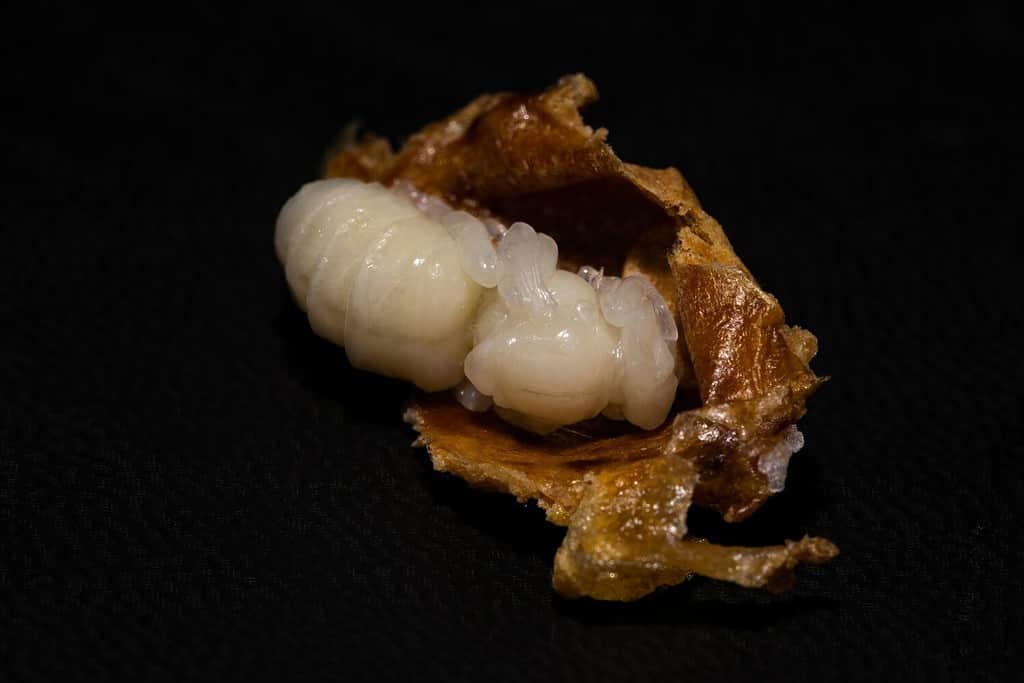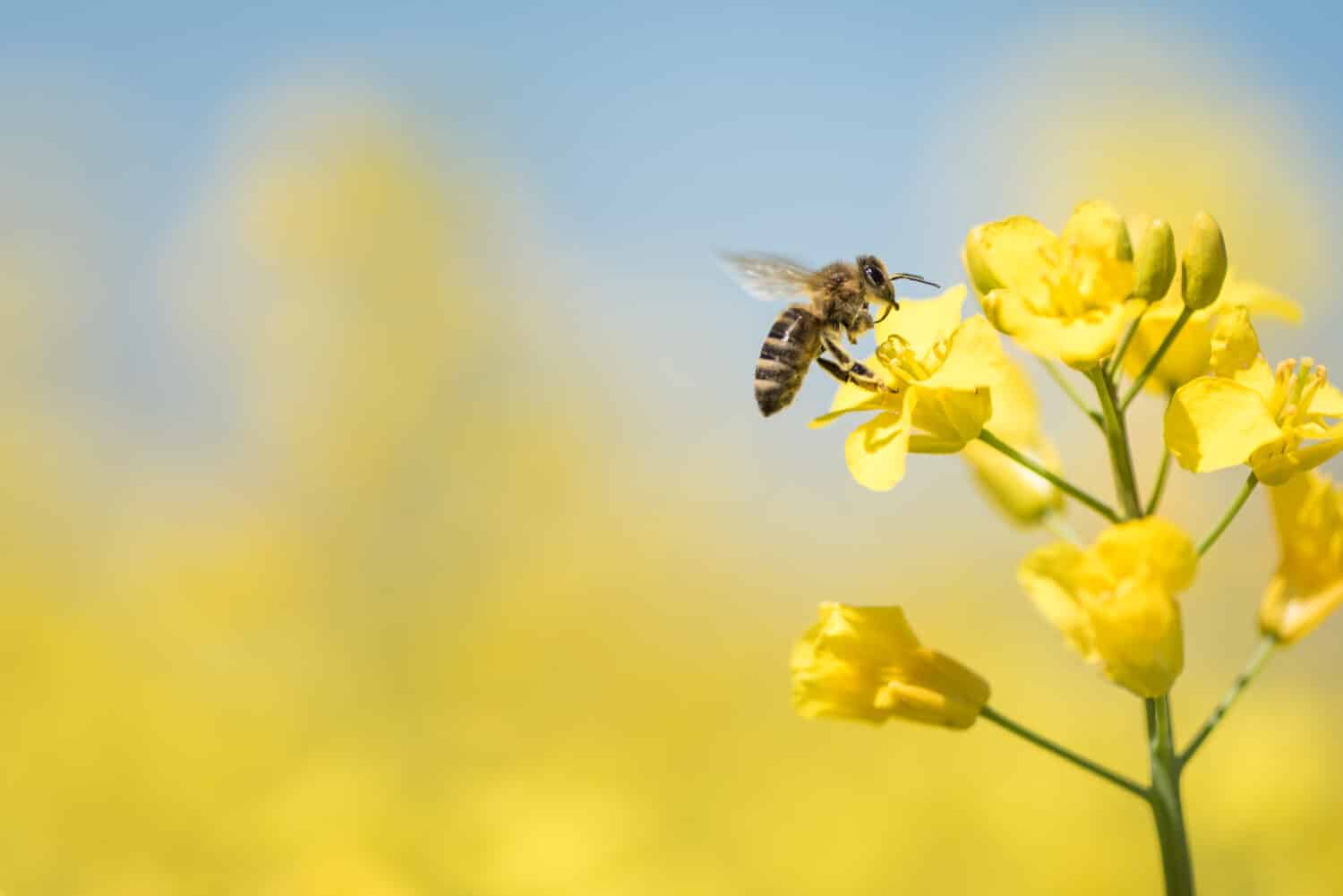There are over 20,000 species of bees in the world, with around 10% of those being social bees. Social bees live in colonies and have a queen, while other bees live separately. All of these different species fall into one of seven families. Knowing the bee type and its family characteristics helps to understand if its species have queens.
The most common species with queen bees are honey bees. They are social bees who live in hives that contain three types of bees: one queen bee, hundreds of drone bees, and thousands of worker bees. The average size of a honey bee hive has anywhere from 20,000 to 80,000 bees depending on the season and food sources. The average hive size is around 60,000 bees. Even in a hive of this size, there will only ever be one queen bee.
As expected, because she is such a valuable part of the colony, the queen lives for quite a long time. Worker bees, the only other females in the hive, live an average of six weeks. Male drone bees live just a bit longer at two months. According to the United States Department of Agriculture (USDA), queen bees can live up to five years in optimal conditions. However, the average lifespan of a queen bee is usually between two to three years.
Types of Bees

Carpenter bees are solitary, while honey and bumble bees are social insects.
©Zety Akhzar/Shutterstock.com
The most common and popular bee family is Apidae. This family is made up of both solitary and social bees. It includes honey, carpenter, and bumble bees in the 5,700 species that fall under the category. Carpenter bees are the largest bees in North America, but they are solitary bees, meaning that they do not have a queen. Honey bees and bumble bees are both social bees. They live in colonies and almost always have a queen bee.
The Halictidae family contains species of bees that vary from solitary to social. They are commonly known as sweat bees because they land on sweating people. They do this to obtain sweat and salt from the skin, which they use as a food source. These bees are a dark, metallic color that sets them apart from traditional-looking bees.
Types of Bees: Solitary Bees

The largest species of bee, Megachile pluto, is solitary and doesn’t have a queen.
© 1000 × 667 pixels • 3.3 × 2.2 in • DPI 300 • JPG 500 × 334 pixels • 1.7 × 1.1 in • DPI 300 • JPG Show more Photo Contributor Wirestock Creators Wirestock Creators/Shutterstock.com
Megachilidae bees are a family of mostly solitary bees. They contain the leafcutter and mason bee species, as well as the largest species of bee in the world — Megachile pluto, aka Wallace’s Giant Bee. They nest in a plethora of different ways, making them one of the most diverse species of the bee family. These bees can be found underground, in rock crevices, inside old plants and trees, and in nests built out of mud.
Another solitary family of bees is the Andrenidae family, which contains about 2,700 ground-nesting bees. These bees are known as mining bees and include the Perdita minima species — the smallest bee species in the world. They live alone and do not have a queen bee.
The Colletidae family contains the species best known as cellophane or plasterer bees. They are called this because they secrete a biological plastic that they use to line their nests and fill cells. Once the bio-plastic dries, it is of the same appearance as cellophane and is waterproof. The Colletidae family of bees is also solitary in nature.
Solitary Bees: Smaller Families

The Melittidae family is the second smallest bee family.
©iStock.com/arlindo71
The Melittidae family is the second smallest and contains just over 200 species of bees. These bees are ground-nesting and solitary. Some of the species in this family collect flower oils rather than nectar or pollen. They live entirely in Africa.
The smallest family of bees is the Stenotritidae type, made up of only 21 bee species that live entirely in Australia. They are solitary and ground-nesting, with many of the species sharing the yellow and black color of honey bees. Others can be a metallic green hue.
Queen Bee Lifespan

A queen bee lives in a pupa stage in a specially-created casing.
©Anthony King Nature/Shutterstock.com
A honey bee colony’s queen bee is chosen at the larva stage. After the older queen begins to lay fewer eggs, is sick, or is otherwise chosen to be replaced by the colony, the worker bees will choose a new queen from the eggs she lays. They do this by preparing a larger cell or cells for the new queen larva. There are often multiple larvae who will become a candidate for queen. After the eggs become larvae, they will be fed a diet of royal jelly continuously.
In the life cycle of bees, all larvae are fed royal jelly for the first few days of life. They are then switched over to a diet of nectar and pollen which prevents them from sexually maturing. The new queen is only fed royal jelly for her entire life to help her mature and take the old queen’s place.
As the new queen grows as a larva over the course of a few days, she is constantly fed and cared for by worker bees. After about five days of feeding, the worker bees will then seal her cell with wax. The queen will then spin a cocoon around herself. At this stage, the new queen is known as a pupa. In this stage of life, she will grow legs, eyes, and wings and begin maturing into an adult bee. This often takes longer than a week, and the new queen emerges to take the old queen’s place.
The New Queen: First Steps

The queen bee kills any rivals to her throne after she emerges from her pupa.
©tuncarif/Shutterstock.com
Once the new queen emerges from her pupa, she seeks out any rivals to the throne and kills them. This includes the other pupas and larvae who were potential candidates for becoming queen. The new queen is generally not responsible for killing the old queen, as the colony usually does this in advance.
At around three weeks of life, the new queen becomes fertile. She will now mate in the air with some of the male drone bees. After a few mating times, the organ inside of her will be full and ready to fertilize any eggs she has. She will never have to mate again and will return to the hive for good. After these first few flights, the queen will never leave the inside of the hive. She will begin producing fertilized eggs for the colony in the cells that her workers make.
Choosing a Queen Bee

Queen bees can lay over 3,000 eggs in a single day.
©iStock.com/Inventori
A queen bee has the capacity to live for around six years, but it’s rare to see a queen live this long. Queens are monitored very closely by their hive to make sure that they are in fit shape to continue being the queen. The colony knows that they are unable to survive without a queen. It’s also crucial for queens to be replaced before they die because they are responsible for creating the next queen for the colony.
A new queen is chosen by or before day two of life in the larvae stage. If the old queen is not alive to produce the larvae, or if the larvae are too old, they may never mature sexually. Being fed the royal jelly continuously from a young age is key in growing the next candidates for queen. A queen bee’s size is very important, based largely on the nutrition she receives in the first few days of her life.
Queen Bee Replacement

The queen bee never leaves her hive once she mates.
©thka/Shutterstock.com
Often, queen bees are killed off by their hive and replaced when their egg production slows. This occurs most commonly around the two to three-year mark. Some bee colonies will also replace their queen within just a few months as a routine way to prevent the queen from aging too much. Though they have the potential to live much longer, the queen has a more extensive lifespan than workers and drones.
The photo featured at the top of this post is ©
Thank you for reading! Have some feedback for us? Contact the AZ Animals editorial team.






